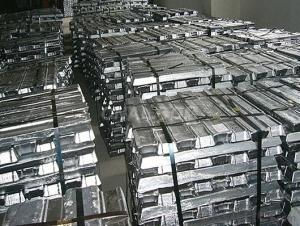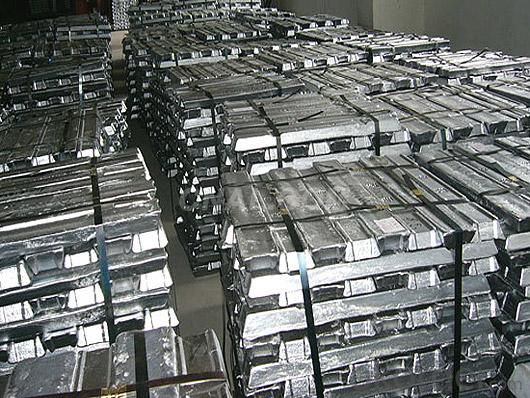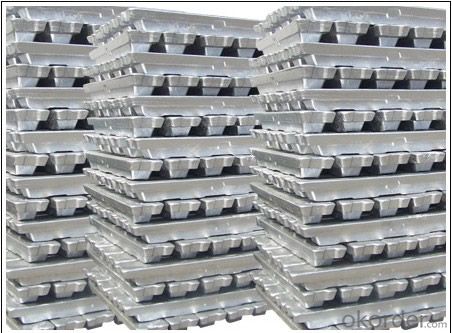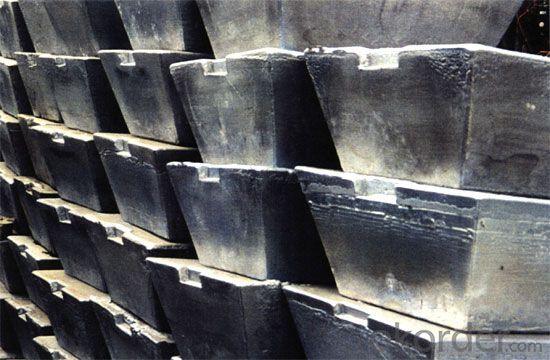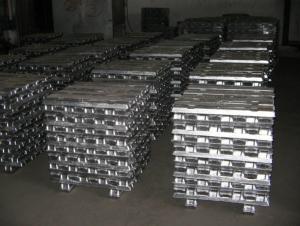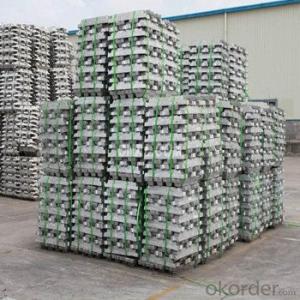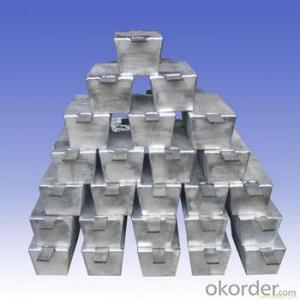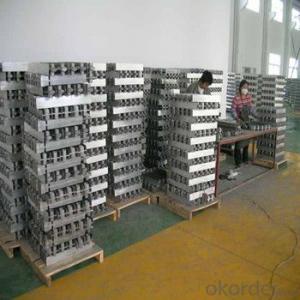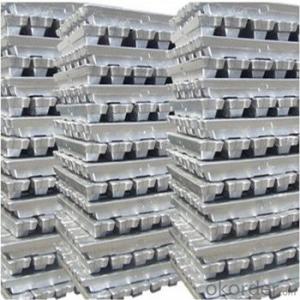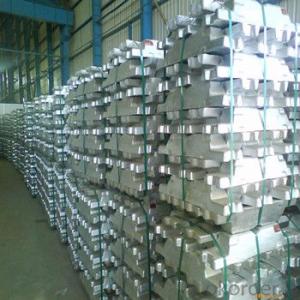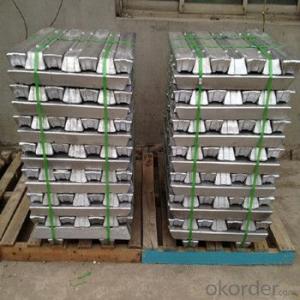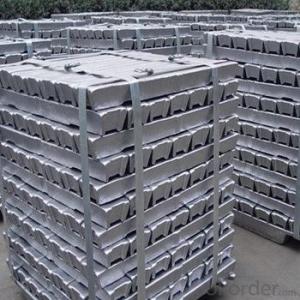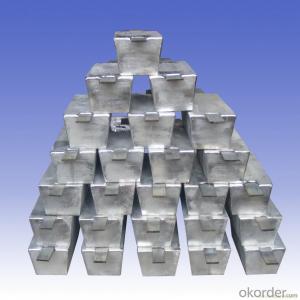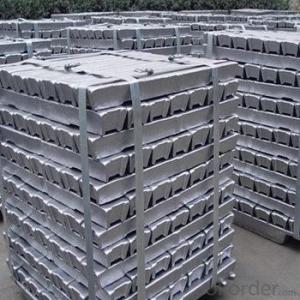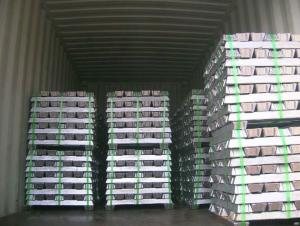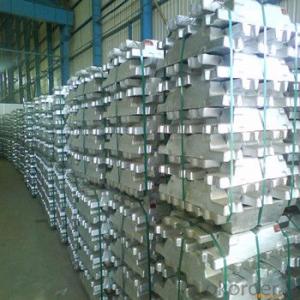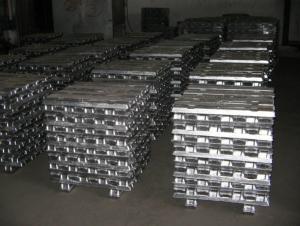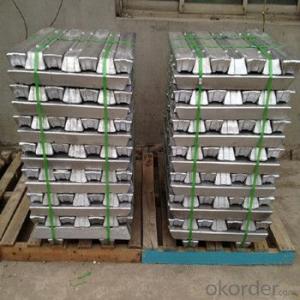Aluminium Ingots With Hgih Quality 99.7%
- Loading Port:
- China main port
- Payment Terms:
- TT OR LC
- Min Order Qty:
- 1000 m.t
- Supply Capability:
- 10000 m.t/month
OKorder Service Pledge
OKorder Financial Service
You Might Also Like
Pure Aluminum Ingot Used for Industry
1.Structure of Aluminum Ingot Description
An ingot is a piece of material, usually metal, that is cast into a shape suitable for further processing. Insteelmaking, it is the first step among semi-finished casting products. Ingots usually require a second procedure of shaping, such as cold/hot working, cutting, or milling to produce a useful final product. Non-metallic and semiconductor materials prepared in bulk form may also be referred to as ingots, particularly when cast by mold based methods.
2.Main Features of the Aluminum Ingot
•High Purity
•High strength
•Fast melting
•Best price
•Good after-service
3. Aluminum Ingot Images
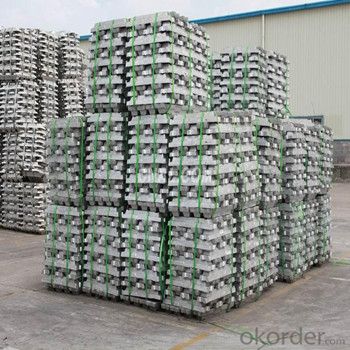
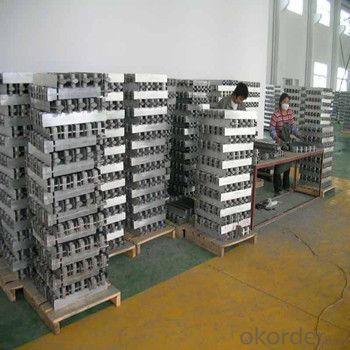
4. Aluminum Ingot Specification
Grade | Chemical Composition % | |||||||||
Al≥ | impurities ≤ | |||||||||
Si | Fe | Cu | Ga | Mg | Zn | Mn | others | Sum | ||
Al99.9 | 99.90 | 0.50 | 0.07 | 0.005 | 0.02 | 0.01 | 0.025 | - | 0.010 | 0.10 |
Al99.85 | 99.85 | 0.80 | 0.12 | 0.005 | 0.03 | 0.02 | 0.030 | - | 0.015 | 0.15 |
Al99.7 | 99.70 | 0.10 | 0.20 | 0.010 | 0.03 | 0.02 | 0.030 | - | 0.030 | 0.30 |
Al99.6 | 99.60 | 0.16 | 0.25 | 0.010 | 0.03 | 0.03 | 0.030 | - | 0.030 | 0.40 |
Al99.5 | 99.50 | 0.22 | 0.30 | 0.020 | 0.03 | 0.05 | 0.050 | - | 0.030 | 0.50 |
Al99.00 | 99.00 | 0.42 | 0.50 | 0.020 | 0.03 | 0.05 | 0.050 | - | 0.050 | 1.00 |
5.FAQ of Aluminum Ingot
We have organized several common questions for our clients,may help you sincerely:
①How about your company?
A world class manufacturer & supplier of castings forging in carbon steel and alloy steel,is one of the large-scale professional investment casting production bases in China,consisting of both casting foundry forging and machining factory. Annually more than 8000 tons Precision casting and forging parts are exported to markets in Europe,America and Japan. OEM casting and forging service available according to customer’s requirements.
②How to guarantee the quality of the products?
We have established the international advanced quality management system,every link from raw material to final product we have strict quality test;We resolutely put an end to unqualified products flowing into the market. At the same time, we will provide necessary follow-up service assurance.
③How long can we receive the product after purchase?
In the purchase of product within three working days, We will arrange the factory delivery as soon as possible. The pecific time of receiving is related to the state and position of customers.Commonly 7 to 10 working days can be served.
- Q: What are the different forms of aluminum ingots available in the market?
- There are several different forms of aluminum ingots available in the market, including standard ingots, T-ingots, sow ingots, and rolled ingots.
- Q: How are aluminum ingots used in the production of electrical enclosures?
- The unique characteristics and properties of aluminum ingots are crucial in producing electrical enclosures. These ingots are melted and cast into specific shapes and sizes to create the main components of the enclosures. To begin with, aluminum is highly desirable for electrical enclosures because of its excellent conductivity. It allows electrical currents to flow efficiently through the enclosure, ensuring the proper functioning of the electronic devices inside. This conductivity helps prevent any interference or disruption in the electrical circuit. Moreover, aluminum is renowned for its lightweight and corrosion-resistant properties. This makes it an ideal choice for electrical enclosures, as they need to be durable and resistant to environmental factors like moisture, dust, and chemicals. Aluminum's corrosion resistance ensures the enclosure remains intact and functional for a longer period, even in harsh conditions. Furthermore, aluminum ingots can be easily machined and fabricated into various shapes, enabling manufacturers to design enclosures that meet specific requirements. The ingots are melted and poured into molds, creating the desired shape and allowing customization and flexibility in the production process. This versatility is particularly important in the electrical industry, where enclosures must accommodate different types of equipment and wiring configurations. Additionally, aluminum ingots are often preferred for their thermal conductivity. Electrical enclosures generate heat due to the operation of enclosed devices. Aluminum efficiently dissipates this heat, preventing overheating and ensuring the safety and longevity of electronic components. In summary, aluminum ingots are extensively used in producing electrical enclosures because of their conductivity, lightweight, corrosion resistance, ease of fabrication, and thermal conductivity. These qualities make aluminum an excellent material choice for creating enclosures that protect and enhance the performance of electrical equipment.
- Q: What kind of aluminum consumption does the furnace compare with natural gas?
- The aluminum loss of the reverberatory furnace is proportional to the melting time: the longer the loss is, the higher the temperature of the flame, the aluminum surface continues to oxidize to alumina powder.
- Q: How are aluminum ingots used in the production of architectural structures?
- Aluminum ingots are commonly used in the production of architectural structures due to their lightweight, durability, and corrosion resistance properties. These ingots are melted down and cast into various shapes, such as beams, columns, and panels, which form the structural framework of buildings. The versatility of aluminum allows for the creation of intricate designs and enables architects to push the boundaries of innovative and sustainable architecture. Moreover, aluminum ingots can be easily recycled, making them an environmentally friendly choice for construction projects.
- Q: How is the purity of aluminum ingots determined?
- The purity of aluminum ingots is determined through various analytical techniques and testing methods. One common method used is spectroscopy, specifically inductively coupled plasma optical emission spectroscopy (ICP-OES) or inductively coupled plasma mass spectrometry (ICP-MS). These techniques are capable of analyzing the elemental composition of the aluminum ingot, including the presence of impurities such as iron, silicon, copper, zinc, and others. Another technique employed is atomic absorption spectroscopy (AAS), which focuses on measuring the concentration of specific elements in the aluminum ingot. This method allows for the detection of trace impurities, as it is highly sensitive and selective for individual elements. Chemical analysis is also utilized to determine the purity of aluminum ingots. Acid digestion methods, such as dissolution in nitric acid or hydrochloric acid, are commonly used to dissolve the ingot and create a solution that can be analyzed for impurities. The resulting solution is then subjected to various tests, including titration, colorimetry, or gravimetric analysis, to quantify the impurities present. In addition to these techniques, physical testing methods can be employed to evaluate the purity of aluminum ingots. These methods involve measuring the physical properties of the ingot, such as density, melting point, or electrical conductivity. Deviations from the expected values can indicate the presence of impurities. Overall, determining the purity of aluminum ingots involves a combination of spectroscopic, chemical, and physical analysis techniques, allowing for a comprehensive assessment of the elemental composition and impurity levels in the ingot sample.
- Q: How is aluminum ingot different from aluminum billet?
- Aluminum ingot and aluminum billet are both forms of raw aluminum, but they differ in terms of shape and size. Aluminum ingot is typically rectangular or trapezoidal in shape and is larger in size compared to aluminum billet. Ingots are usually cast in a mold and are used as the initial material for various aluminum products. On the other hand, aluminum billet is cylindrical or round in shape and is smaller in size. Billets are typically created by extruding or casting and serve as the starting point for further processing, such as machining or rolling, to create specific aluminum products.
- Q: How is aluminium ingot produced?
- There are mainly three types of bauxite for the production of alumina: gibbsite, diaspore and diaspore. In the world has proven reserves of bauxite, 92% is weathering lateritic bauxite, belonging to gibbsite type bauxite. The characteristics of these is low silicon, high iron and high silicon aluminum ratio, concentrated in West Africa, Oceania and central and South america. The remaining 8% are sedimentary type bauxite, belong to diaspore and diaspore type, low grade, mainly in Greece, the former Yugoslavia and Hungary and other places. Because of the different characteristics of the three kinds of bauxite, different production processes have been adopted in the alumina production enterprises. At present, there are three kinds of Bayer process, the alkali lime sintering method and the Bayer sintering combined method. High grade bauxite is usually produced by Bayer process, and medium or low grade bauxite is produced by combined method or sintering method. Because of its simple process and low energy consumption, Bayer process has become the most important method in the production of alumina at present, and the output is about 95% of the total alumina production.
- Q: What are the different cutting techniques for aluminum ingots?
- There are several cutting techniques that can be used for aluminum ingots, depending on the desired outcome and the specific application. 1. Bandsaw cutting: This method involves using a bandsaw machine with a specialized blade to cut through the aluminum ingot. Bandsaw cutting is commonly used for large-scale production as it allows for high precision and accuracy in cutting. 2. Circular saw cutting: Circular saws equipped with carbide-tipped blades can also be used to cut aluminum ingots. This method is suitable for both small-scale and large-scale cutting operations, offering a relatively fast cutting speed. 3. Waterjet cutting: Waterjet cutting uses a high-pressure stream of water mixed with an abrasive material to cut through the aluminum ingot. This technique is ideal for precise and intricate cuts as it does not generate heat, minimizing the risk of thermal distortion. 4. Plasma cutting: Plasma cutting involves using a plasma torch to melt and cut through the aluminum ingot. It is a versatile cutting method that can be used for various thicknesses and shapes. 5. Laser cutting: Laser cutting utilizes a highly focused laser beam to melt and vaporize the aluminum, creating a clean and precise cut. This technique is particularly effective for thin aluminum ingots. 6. Shearing: Shearing is a cutting technique that involves applying a shearing force to the aluminum ingot, typically using a guillotine-style machine. This method is suitable for cutting thicker ingots and can be used for both straight and curved cuts. Each cutting technique has its advantages and limitations, and the choice of method depends on factors such as the desired cut quality, speed, complexity of the shape, and available equipment. It is recommended to consult with experts or professionals in the field to determine the most suitable cutting technique for a specific application.
- Q: What are the different shapes and sizes of aluminum ingots?
- Aluminum ingots come in various shapes and sizes depending on the specific requirements of the industry they are being used in. The most common shape of aluminum ingots is rectangular, with a length ranging from a few inches to several feet, and a width and height that vary proportionately. These rectangular ingots are typically used in industries such as construction, automotive, and aerospace. In addition to rectangular ingots, there are also cylindrical-shaped aluminum ingots. These ingots have a circular cross-section and can have varying diameters and lengths. Cylindrical ingots are commonly used in the manufacturing of electrical components, such as wires and cables, due to their uniform shape and ease of processing. Moreover, aluminum ingots can also be found in other shapes such as trapezoidal or triangular, although these are less common and are usually customized to meet specific industrial requirements. These irregular-shaped ingots are often used in specialized applications where unique designs or specific mechanical properties are needed. The sizes of aluminum ingots can vary widely as well. Smaller ingots are typically used for smaller-scale applications or for testing purposes, whereas larger ingots are used in heavy industries where large quantities of aluminum are required. The weight of an aluminum ingot can range from a few pounds to several tons, depending on its size and intended use. Overall, the shapes and sizes of aluminum ingots are diverse and can be tailored to meet the specific needs of different industries and applications.
- Q: How are aluminum ingots used in the production of aerospace components?
- Aluminum ingots play a crucial role in the production of aerospace components due to their unique properties and characteristics. These ingots are melted down and refined to create high-quality aluminum alloys that are specifically designed to meet the demanding requirements of the aerospace industry. One of the main reasons aluminum is widely used in aerospace manufacturing is its low density. Aluminum is a lightweight material, which helps reduce the overall weight of the aircraft, resulting in improved fuel efficiency and increased payload capacity. This is particularly crucial in the aerospace industry, where every kilogram saved translates into significant cost savings and operational advantages. Another key advantage of aluminum ingots is their excellent strength-to-weight ratio. By alloying aluminum with other elements such as copper, magnesium, or zinc, aerospace engineers can create alloys that possess exceptional strength and structural integrity while maintaining a low weight. These alloys are then used to manufacture various components, such as airframes, wings, fuselage sections, and structural supports, which need to withstand extreme conditions and stresses during flight. Furthermore, aluminum ingots offer exceptional corrosion resistance, making them ideal for aerospace applications. Aircraft are subjected to harsh environments, including exposure to moisture, saltwater, and temperature fluctuations. Aluminum alloys, derived from these ingots, possess a natural oxide layer that provides a protective barrier against corrosion, ensuring the longevity and durability of the aerospace components. Additionally, aluminum ingots can be easily cast, machined, and formed into intricate shapes and designs, allowing for the production of complex aerospace components with high precision. This versatility is essential in the aerospace industry, where intricate and custom parts are required to meet the specific needs and requirements of different aircraft models. In summary, aluminum ingots are essential in the production of aerospace components due to their lightweight nature, excellent strength-to-weight ratio, corrosion resistance, and versatility in manufacturing processes. By utilizing aluminum ingots and their derived alloys, aerospace manufacturers can achieve the perfect balance between performance, durability, and efficiency in their aircraft, contributing to the advancement and safety of the aerospace industry.
Send your message to us
Aluminium Ingots With Hgih Quality 99.7%
- Loading Port:
- China main port
- Payment Terms:
- TT OR LC
- Min Order Qty:
- 1000 m.t
- Supply Capability:
- 10000 m.t/month
OKorder Service Pledge
OKorder Financial Service
Similar products
Hot products
Hot Searches
Related keywords
